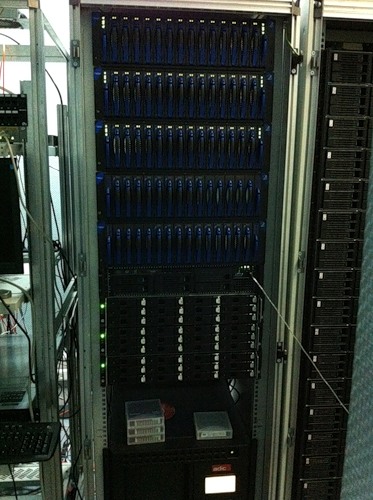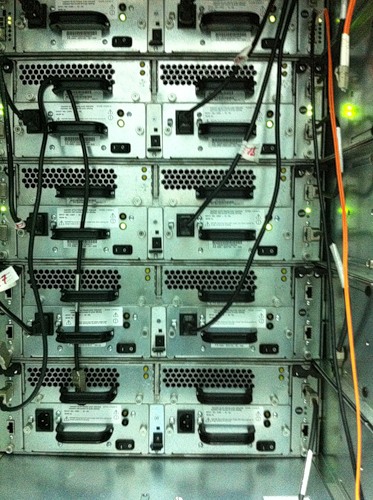Building a SAN-based unified storage with a shared file space
In production, the task arose of building a unified data warehouse for a small network (20 workstations).
Typical and trivial options in the form of network sharing or NFS mapings have disappeared, in view of the fact that 1Gbit networks are very small for our tasks, and 10Gbit solutions in Russia are more theoretical, because: first, very expensive, -second, is not available. To buy, for example, a full-fledged switch for 16 ports of 10 Gbit each is frankly impossible. Or for a lot of money again. Although what is happening now in the iron market, I will say honestly, I no longer know. Since what is already built - do not break the same.
In this case, we turn to the version that works for us. Fiber Channel based network.
So, the network topology looks very trivial:
Three different stackers with dual controllers look into two different Qlogic SANbox 5600 switches.
In the same switches users are scattered equally + the main file server is watching two controllers in both switches.
Something like this from the server side:

on top are 5 shelves Sanbloc on the good old SCSI total volume on the shelf 1TB in the 5th raid.
Next comes the file server, mentioned in the configuration,
after server: 3 shelves (Xyratex F5412E + slave and Xyratex F6412E) on SATA, but there are sandwiches from Raid0 and Raid10.
And at the very bottom, it did not fit into the frame: ADIC Scalar 100 tape library with 60 tapes, old by today's standards LTO-2 drives, which serves as a means of resetting data for long-term storage (and backup itself) and the hope that data will never be needed .
Well, a couple of frames of the back side (do not expect beauty will not work with beautifully laid cables)


Now how it works.
All sliced LUNs on storajs, if they are not mapped, are visible to all users at once, in our case, all LUNs are mapped to the file server, and only 1 that has been sliced for general use is not mapped and is available to everyone. He is what interests us. For each user, such a LUN is available as a separate hard disk, with everyone seeing the data stored on it.
But as you know, most file systems do not support non-monopolized use, with the exception of cluster ones, such as Microsoft cfs or zfs from IBM.
Classic ntfs when sharing will ultimately lead to a complete collapse of the file structure. You can of course apply the examples above: cfs or zfs - but in the first version, everyone will have to install windows server, in the second case to buy a license, with a very non-humane price tag. I will not lie, but the last time the price was announced was about 5k ye for each client.
There is also another option - xSAN from the apple company, but I don’t want to get attached to MAC OS X, since most of the windows-applications are used in the work, so the option of changing the operating system was also not considered.
There is a half-measure to which they resorted: an add-on over the file system called MetaSAN. Who is interested - can read in detail on tiger-technology.com .

In short, it works like this, the MetaSAN client acts as a driver between the LUN and the operating system, all read-write operations are conducted directly via Fiber Channel, and changes to the file structure are transmitted to the main MetaSAN controller over a normal network, in which case we have disk performance up to 4 Gbit on optics, and a very small flow of information on the e-net.
The weak point in this case is the data controller, but it can be assigned automatically to any machine, or by prioritizing the machine directly inaccessible to ordinary users, in our case, the file server, which, as a rule, is always available, also has a redundant connection to the stack. via multi-path.
')
And as a remark:
Any use of conventional ethernet (nfs, smb, iscsi) in the classical sense for file transfer is not very suitable, for a banal reason for network delays. Most users work with uncompressed FullHD content, and ethernet, due to its features, is not able to output data with minimal equally constant delays, which greatly complicates playback FullHD video.
There will be questions: I will answer with pleasure.
Typical and trivial options in the form of network sharing or NFS mapings have disappeared, in view of the fact that 1Gbit networks are very small for our tasks, and 10Gbit solutions in Russia are more theoretical, because: first, very expensive, -second, is not available. To buy, for example, a full-fledged switch for 16 ports of 10 Gbit each is frankly impossible. Or for a lot of money again. Although what is happening now in the iron market, I will say honestly, I no longer know. Since what is already built - do not break the same.
In this case, we turn to the version that works for us. Fiber Channel based network.
So, the network topology looks very trivial:
Three different stackers with dual controllers look into two different Qlogic SANbox 5600 switches.
In the same switches users are scattered equally + the main file server is watching two controllers in both switches.
Something like this from the server side:

on top are 5 shelves Sanbloc on the good old SCSI total volume on the shelf 1TB in the 5th raid.
Next comes the file server, mentioned in the configuration,
after server: 3 shelves (Xyratex F5412E + slave and Xyratex F6412E) on SATA, but there are sandwiches from Raid0 and Raid10.
And at the very bottom, it did not fit into the frame: ADIC Scalar 100 tape library with 60 tapes, old by today's standards LTO-2 drives, which serves as a means of resetting data for long-term storage (and backup itself) and the hope that data will never be needed .
Well, a couple of frames of the back side (do not expect beauty will not work with beautifully laid cables)


Now how it works.
All sliced LUNs on storajs, if they are not mapped, are visible to all users at once, in our case, all LUNs are mapped to the file server, and only 1 that has been sliced for general use is not mapped and is available to everyone. He is what interests us. For each user, such a LUN is available as a separate hard disk, with everyone seeing the data stored on it.
But as you know, most file systems do not support non-monopolized use, with the exception of cluster ones, such as Microsoft cfs or zfs from IBM.
Classic ntfs when sharing will ultimately lead to a complete collapse of the file structure. You can of course apply the examples above: cfs or zfs - but in the first version, everyone will have to install windows server, in the second case to buy a license, with a very non-humane price tag. I will not lie, but the last time the price was announced was about 5k ye for each client.
There is also another option - xSAN from the apple company, but I don’t want to get attached to MAC OS X, since most of the windows-applications are used in the work, so the option of changing the operating system was also not considered.
There is a half-measure to which they resorted: an add-on over the file system called MetaSAN. Who is interested - can read in detail on tiger-technology.com .

In short, it works like this, the MetaSAN client acts as a driver between the LUN and the operating system, all read-write operations are conducted directly via Fiber Channel, and changes to the file structure are transmitted to the main MetaSAN controller over a normal network, in which case we have disk performance up to 4 Gbit on optics, and a very small flow of information on the e-net.
The weak point in this case is the data controller, but it can be assigned automatically to any machine, or by prioritizing the machine directly inaccessible to ordinary users, in our case, the file server, which, as a rule, is always available, also has a redundant connection to the stack. via multi-path.
')
And as a remark:
Any use of conventional ethernet (nfs, smb, iscsi) in the classical sense for file transfer is not very suitable, for a banal reason for network delays. Most users work with uncompressed FullHD content, and ethernet, due to its features, is not able to output data with minimal equally constant delays, which greatly complicates playback FullHD video.
There will be questions: I will answer with pleasure.
Source: https://habr.com/ru/post/110732/
All Articles